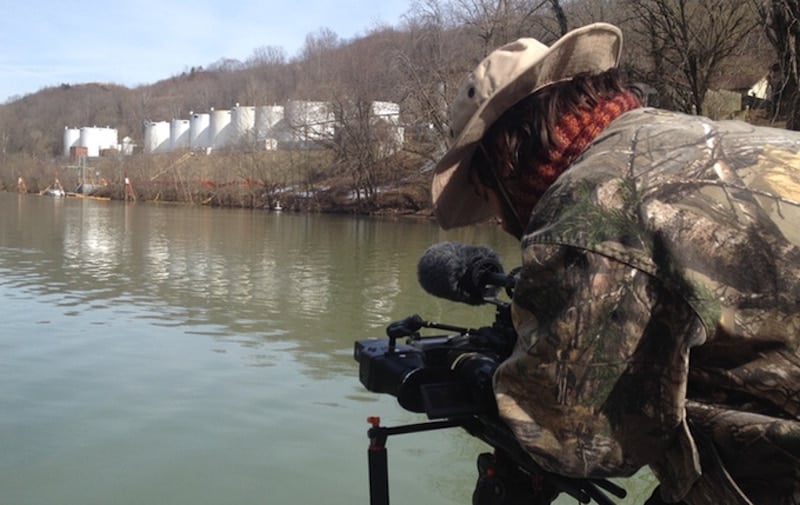
It’s not without irony that two feature-length documentaries creating film fest buzz last week in Park City were about the coming fresh water crisis — even as Utah and other states in the western U.S. currently are experiencing record snowfall.
Both cautionary tales, however, make the case that the world’s fresh water supply is in dire straits.
Director Cullen Hoback’s What Lies Upstream, which premiered at Slamdance, blows open a water scandal in West Virginia bigger than the more notorious one in Flint, Michigan.
In 2014, 400,000 gallons of a mysterious chemical, 4-Methylcyclohexanemethanol, used in the processing of coal, was spilled into the Elk River. The result was 300,000 residents over an area comprising one third of the state were left without safe drinking water.
Hoback, who has family ties in the state, knows well the Appalachian territory, which gives him the advantage of disarming government and company officials who might otherwise be more guarded.
It’s hard to find a hero in the West Virginia debacle. A doctor there who was among the first to sound the alarm bell about the potential health risk of the chemical spill is eventually shown to be compromised as he takes a cushy state agency job.
And that provides the underlying message to the film: That government agencies meant to protect the public’s safety are ultimately more interested in protecting their reputation and cannot be trusted.
The film eventually addresses the crisis in Flint, Michigan, but it seems obligatory rather than insightful as the director argues that the hundreds of chemicals with unknown risks are being released unchecked into drinking supplies virtually everywhere, posing an imminent worldwide health crisis.
That’s more hyperbole than fact, but Hoback does effectively portray the Elk River spill as a harbinger.
Water & Power: A California Heist keeps the focus on the Golden State but poses that corporate corruption is at least as dangerous to the public supply of safe drinking water as accidental spills and indifferent bureaucrats.
Director Marina Zenovich’s documentary for National Geographic, which premiered at Sundance, traces the power grab for water in the state to the early 20th century when three competing tribes emerged: urban planners, famers and nascent environmentalists (mainly from the northern part of the state, whose residents resented their parched neighbors to the south taking anything of theirs without exacting a price).

much responsible for California’s severe water drought as Mother Nature
Eventually, we learn it was California Governor Pat Brown — father of the state’s current governor — who engineered a compromise between the competing parties, resulting in the 400-mile California Aqueduct, one of the great engineering public works in history.
Essentially a system of giant pipes and canals, it brings fresh water from upstate to downstate, and thus guaranteed the future growth of Los Angeles and other Southern California cities.
All was well until a series of droughts beginning in the Eighties and culminating last year produced a real shortage of fresh water.
Suddenly, the era of enough water for everyone and everything was reduced to stark questions like, which deserved water more — residents of the state’s Tulare County who were forced to import their drinking water, or agri-business that established trendy but water-hungry new cash crops like almonds, pistachios and pomegranates (to the delights of local government officials eager to find new jobs and tax revenues for constituents).
As Nat Geo docs are wont to do, the film covers a lot of ground, and among the array of characters that zip by, it’s difficult to discern a villain or even the root cause of the problem other than generic corruption.
If all this sounds vaguely familiar, it’s because Roman Polanski tackled the same issue — private profiteering from the state’s public water resources — in his classic detective story Chinatown. Polanski wisely identified a chief villain in the plot, businessman Noah Cross, superbly played by John Huston.
Water & Power hints at Noah Cross’ real-life, modern-day counterparts — Stewart Resnick and his wife Lynda. Through a series of secret meetings with government officials Stewart managed to grab 60 percent of the excess fresh water supply from the California Aqueduct for his private industrial-sized farms in the state’s high desert Kern County — even as the rest of the state was experiencing a drought of historic proportions.
His wife very publicly creates a public park for the children in the small town surrounded by the Resnick’s new agribusiness orchards, but neglects to provide the residents with a solution to their drinking water that has been polluted with arsenic and other pesticides. But having never secured an interview with the couple, the effort to explore them further is jettisoned.
Both documentaries send up a red flag. Despite the current season of high snowfall and a president who dismisses climate change as another liberal conspiracy, the crisis in fresh water is upon us.
And it’s up to us — not government officials or big business — to solve it.